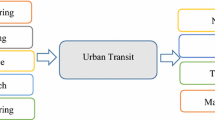Abstract
Delay, as an inevitable real-world phenomenon, is usually ignored in transport network design. A model of urban hybrid transport system with stochastic delay was created on the basis of the idealized public transport system design. After formulating the total trip time cost composed of accessing time in the sub-region of the city, waiting time at the public transport station, and in-vehicle time in the public transit network, the analytical properties of the total trip time cost function were investigated. The results show that in the urban hybrid transport network design, the total trip time cost reaches its approximate minimum in a δ-neighbourhood of buffer time of 1.5 min, and that through modelling optimal delay in hybrid transport system, the maximal synchronization can be achieved and operational efficiency and passenger satisfaction can be improved. The proposed modelling and analytical investigations are attempts to contribute to more realistic modelling of future idealized public transport system that involves more practical constraints.
Similar content being viewed by others
References
LOWSON M. Idealised models for public transport systems [J]. International Journal of Transport Management, 2004, 2(3/4): 135–147.
CHOWDHURY M S, CHIEN S I. Dynamic vehicle dispatching at intermodal transfer station [C]// Proceedings of the 80th Transportation Research Board Annual Meeting, Washington DC: TRB, 2001: 3101–3108.
PEDERSEN M B, NIELSEN O A, JANSSEN L N. Minimizing passenger transfer times in public transport timetables [C]// Proceedings of the 7th conference of Hong Kong Society for Transportation Studies. Hong Kong, 2002.
HALL R, DESSOUKY M, LU Q. Optimal holding times at transfer stations [J]. Computers and Industrial Engineering, 2001, 40(4): 379–397.
SHRIVASTAVA P, O’MAHONY M. A model for development of optimized feeder routes and coordinated schedules—A genetic algorithms approach [J]. Transport Policy, 2006, 13(5): 413–425.
GOVERDE R M P. Transfer stations and synchronization [R]. Technical Report, TRAIL, Delft: Delft University of Technology, The Netherlands, 1999.
LIEBCHEN C, SCHACHTEBECK M, SCHÖBEL A, STILLER S, and PRIGGE A. Computing delay resistant railway timetables [R]. Technical Report TR-0066, ARRIVAL Report, Berlin: Technische Universität Berlin, 2007.
FUNG S W C, TONG C O, WONG S C. Predicting the performance of a mass transit system by using a conventional network model [C]// Proceedings of the Croucher Advanced Study Institute (ASI) on Advanced Modeling for Transit supply and Passenger Demand. Hong Kong, Hong Kong Polytechnic University, 2004.
VANSTEENWEGEN P, OUDHEUSDEN D V. Decreasing the passenger waiting time for an intercity rail network [J]. Transportation Research (Part B), 2007, 41(4): 478–492.
LIAW C, WHITE C C, BANDER J J. A decision support system for the bimodal dial-a-ride problem [J]. IEEE Transactions on Systems, Man, and Cybernetics—Part A: Systems and Humans, 1996, 26(5): 552–565.
PARENT M, GALLAIS G. Cybercars: Review of first projects [C]// Proceedings of the 9th ASCE International Conference on Automated People Movers (APM 03). Singapore, 2003.
GUO J Y, BHAT C R. Operationalizing the concept of neighborhood: Application to residential location choice analysis [J]. Journal of Transport Geography, 2007, 15(1): 31–45.
HOLROYD E M. The optimum bus service: A theoretical model for a large uniform urban area [C]// Proceedings of the 3rd International Symposium on the Theory of Traffic Flow. New York: Elsevier, 1967.
WARDMAN M. Public transport values of time [J]. Transport Policy, 2004, 11(4): 363–377.
Author information
Authors and Affiliations
Corresponding author
Additional information
Foundation item: Project (70671008) supported by the National Natural Science Foundation of China, Project (3340-74236000003) supported by the Scientific Research Innovation Fund Project for Graduate Student of Hunan Province, China
Rights and permissions
About this article
Cite this article
Li, Xm., Zeng, Mh., Fu, Bb. et al. Synchronous hybrid transport network design. J. Cent. South Univ. Technol. 16, 332–338 (2009). https://doi.org/10.1007/s11771-009-0056-9
Received:
Accepted:
Published:
Issue Date:
DOI: https://doi.org/10.1007/s11771-009-0056-9




